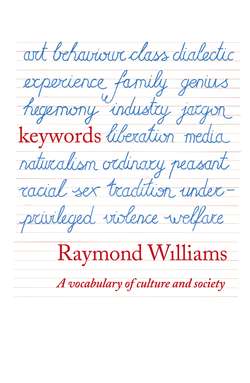Читать книгу Keywords: A Vocabulary of Culture and Society - Raymond Williams - Страница 9
AESTHETIC
ОглавлениеAesthetic first appeared in English in C19, and was not common before mC19. It was in effect, in spite of its Greek form, a borrowing from German, after a critical and controversial development in that language. It was first used in a Latin form as the title of two volumes, Aesthetica (1750–8), by Alexander Baumgarten (1714–62). Baumgarten defined beauty as phenomenal perfection, and the importance of this, in thinking about art, was that it placed a predominant stress on apprehension through the senses. This explains Baumgarten’s essentially new word, derived from rw aisthesis, Gk – sense perception. In Greek the main reference was to material things, that is things perceptible by the senses, as distinct from things which were immaterial or which could only be thought. Baumgarten’s new use was part of an emphasis on subjective sense activity, and on the specialized human creativity of art, which became dominant in these fields and which inherited his title-word, though his book was not translated and had limited circulation. In Kant beauty was also seen as an essentially and exclusively sensuous phenomenon, but he protested against Baumgarten’s use and defined aesthetics in the original and broader Greek sense of the science of ‘the conditions of sensuous perception’. Both uses are then found in occasional eC19 English examples, but by mC19 reference to ‘the beautiful’ is predominant and there is a strong regular association with art. Lewes, in 1879, used a variant derived form, aesthesics, in a definition of the ‘abstract science of feeling’. Yet anaesthesia, a defect of physical sensation, had been used since eC18; and from mC19, with advances in medicine, anaesthetic – the negative form of the increasingly popular adjective – was widely used in the original broad sense to mean deprived of sensation or the agent of such deprivation. This use of the straight negative form led eventually to such negatives as unaesthetic or nonaesthetic in relation to the dominant use referring to beauty or to art.
In 1821 Coleridge wished that he could ‘find a more familiar word than aesthetics for works of TASTE and CRITICISM’ (qq.v.), and as late as 1842 aesthetics was referred to as ‘a silly pedantical term’. In 1859 Sir William Hamilton, understanding it as ‘the Philosophy of Taste, The theory of the Fine Arts, the Science of the Beautiful, etc.’, and acknowledging its general acceptance ‘not only in Germany but throughout the other countries of Europe’, still thought apolaustic would have been more appropriate. But the word had taken hold and became increasingly common, though with a continuing uncertainty (implicit in the theory which had led to the coinage) between reference to art and more general reference to the beautiful. By 1880 the noun aesthete was being widely used, most often in a derogatory sense. The principles and practices of the ‘aesthetic movement’ around Walter Pater were both attacked and sneered at (the best-remembered example is in Gilbert’s Patience (1880)). This is contemporary with similar feeling around the use of culture by Matthew Arnold and others. Aesthete has not recovered from this use, and the neutral noun relating to aesthetics as a formal study is the earlier (mC19) aesthetician. The adjective aesthetic, apart from its specialized uses in discussion of art and literature, is now in common use to refer to questions of visual appearance and effect.
It is clear from this history that aesthetic, with its specialized references to ART (q.v.), to visual appearance, and to a category of what is ‘fine’ or ‘beautiful’, is a key formation in a group of meanings which at once emphasized and isolated SUBJECTIVE (q.v.) sense-activity as the basis of art and beauty as distinct, for example, from social or cultural interpretations. It is an element in the divided modern consciousness of art and society: a reference beyond social use and social valuation which, like one special meaning of culture, is intended to express a human dimension which the dominant version of society appears to exclude. The emphasis is understandable but the isolation can be damaging, for there is something irresistibly displaced and marginal about the now common and limiting phrase ‘aesthetic considerations’, especially when contrasted with practical or UTILITARIAN (q.v.) considerations, which are elements of the same basic division.
See ART, CREATIVE, CULTURE, GENIUS, LITERATURE, SUBJECTIVE, UTILITARIAN
